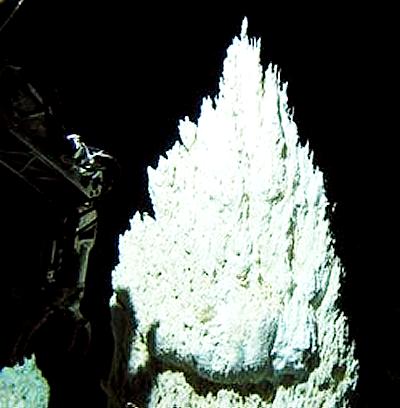March 10, 2005
Life in ‘Lost City’
The hydrothermal vents were miles from where anyone could have imagined. One massive seafloor vent was an unheard of 18 stories tall. And all were creamy white and gray, suggesting a very different composition than vent systems studied since the 1970s.
Scientists who named the spot Lost City knew they were looking at something never seen before when the field was serendipitously discovered in December 2000 during a National Science Foundation expedition to the mid-Atlantic.
Last week in Science, researchers published for the first time findings about the gases produced at Lost City and the organisms that make their living off them. Both are so different from so-called black-smoker hydrothermal vents that they may provide a whole new avenue for looking for the earliest life on Earth and for signs of life on other planets, according to Deborah Kelley, UW oceanographer and lead author of the Science article.
Microorganisms at Lost City are living in fluids with alkaline pH that ranges from 9 to 11, which is nearly as caustic as Liquid-Plumr, Kelley says. This compares to the previously studied black-smoker vents where organisms are well adjusted to acidic pHs.
Further, she says, Lost City microbes appear to live off bountiful methane and hydrogen. Absent is carbon dioxide, the key energy source for life at black-smoker vents. And there is little hydrogen sulfide and only very low traces of metals, on which many of the microbes at the other kind of vents depend.
The difference in what’s available is because water circulates through the Lost City hydrothermal vent field via serpentinization, a chemical reaction between seawater and the mantle rock on which Lost City sits. The resulting fluids are 105 F to 170 F. At the other kind of field, first discovered in the early 1970s, volcanic activity or magma drives venting and fluids can reach 700 F. The vents at such sites are often referred to as black smokers because some emit hot, mineral-laden fluid that looks like dark, billowing smoke when it hits the icy cold seawater.
Carbonate minerals from fluids at Lost City drape nearby cliffs in brilliant white and form vents ranging in shape from tiny toadstools to the 18-story column, named Poseidon, which dwarfs most known black smoker vents by at least 100 feet. Some places resemble the sort of deposits one might see in spectacular caves with spires and smoothly rippled surfaces in a complex three-dimensional array, says Duke University’s Jeffrey Karson, co-author on the paper.
Another marked difference being published for the first time this week concerns the diversity of life. The fluids at Lost City harbor large amounts of microorganisms — comparable to what’s found in rich organic sediments. However the diversity of species is low, with, for example, just a handful of methane-producing and methane-consuming Archaea.
In surprising contrast, researchers discovered Lost City has a diversity of “larger” organisms that’s as high, or higher, than any known black-smoker vent sites. Missing from Lost City are the tubeworms, abundant shrimp and other readily observed organisms that heavily blanket some black smokers. The high diversity revealed itself only after a 2003 expedition when the biology team led by Woods Hole Oceanographic Institution’s Timothy Shank analyzed water samples “vacuumed” from around the vents.
“There aren’t a lot of each kind of animal; most are only a centimeter in size and have translucent or invisible shells so it’s no wonder we didn’t suspect the actual diversity,” says Kelley, who was chief scientist on the expedition, which like the 2000 voyage was funded by the National Science Foundation. Other large organisms include crabs, corals and fish.
Kelley will be co-principal investigator on another science expedition to Lost City this summer — without leaving the UW. She’ll use state-of-the-art communication technology to help direct investigations at sea during a mission with co-PI Bob Ballard, his Institute for Exploration, the Jason Foundation for Education and National Oceanic and Atmospheric Administration’s ship and funding. Audiences at participating aquariums, museums and 20 Boys and Girls Clubs across the nation will have access to satellite transmissions during the journey.
Although nobody has yet found another field like Lost City, Kelley says she’s 100 percent sure others exist because there are so many other places mantle rock has been thrust up through the seafloor, exposing it to seawater and serpentinization.
Even more such rocks were present on early Earth, Kelley says.
“We don’t, in most places, have access to early Earth conditions so if we can understand the chemical reactions, sources of energy and how fluids circulate through Lost City, it may give us insight into how life started on this planet,” Kelley says.
She says Lost City could be compared to places on land with similar rock that is very old, such as that exposed in Barberton, South Africa, which is 3.5 billion years old. Perhaps Lost City can provide additional biomarkers, the chemical remnants of organisms, with which to look for life in those ancient rocks or on other planets.
The work being published was funded by the NSF, NASA Astrobiology Institute and a Swiss national science grant.
“The findings are an exciting example of NSF’s commitment to discovery through basic research,” said Bilal Haq, director of NSF’s marine geology and geophysics program. “Lost City shows us that geological, chemical and biological processes are intimately linked at a primal environment, and lends strong support to the need for interdisciplinary approaches to scientific research.”
Tag(s): Deborah Kelley • Lost City hydrothermal vents • oceanography
